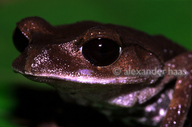|
Leptobrachium montanum Fischer, 1885
Mountain Spadefoot Toad, Montane Litter Frog, Mountain Litter Frog | family: Megophryidae subfamily: Leptobrachiinae genus: Leptobrachium |
 © 2003 Alexander Haas (1 of 8)
|
|
|
|
Description Leptobrachium montanum is morphologically similar to Leptobrachium gunungensis. Both frogs belong to the family Megophryidae and are considered sibling species. These two species can be distinguished slightly by distribution and more notably by their distinct calls (see Life History section; Malkmus 1996). The dorsal surfaces are brown and appear to be reticulated. There are black-fringed round spots irregularly scattered on the dorsum. The limbs may have black bands and white or pale yellow dot-like spots. The belly is lighter than the dorsum, and may be grayish with bright yellow dots concentrated in the chin and throat area. Outside the iris, the eye sclera is white (Fisher 1885). The tadpoles have a strong tail with a well-developed caudal fin. The snout of the tadpoles is long and blunt. The tail is patterned with dark spots. As the tadpole ages and develops, the number of dark spots on the tail increases until the body color is darker in general (Nodzenski et al. 1989). Distribution and Habitat Country distribution from AmphibiaWeb's database: Indonesia, Malaysia Malaysian region distribution from AmphibiaWeb's database: Sabah, Sarawak
Life History, Abundance, Activity, and Special Behaviors The advertisement call of L. montanum is a loud ‘quak’, which sounds similar to a duck quack (Fischer 1885). The species breeds in small streams of montane forests where the larvae develop within small pools of breeding streams (Inger et al. 2004). The tadpoles are large with bulky bodies (>70 mm) and are more active during the night, although they can be seen during the day (Nodzenski et al. 1989).
References
Fischer, J. G. 1885. Ueber eine Kollektion von Amphibien und Reptilien aus Südost-Borneo. Archiv für Naturgeschichte, 51: 41-72. Inger, R. F. and Tan, F. L. (1996). ''Checklist of the frogs of Borneo.'' The Raffles Bulletin of Zoology, 44(2), 551-574. Inger, R. F., Iskandar, D., Das, I., Stuebing, R., Lakim,M., Yambun, P. 2004. Leptobrachium montanum. In: IUCN 2012 IUCN Red List of Threatened Species. Version 2013.1. Downloaded on 21 March 2013 Malkmus, R. 1996. Leptobrachium gunungensis sp. n. (Anura: Pelobatidae) vom Mount Kinabalu, Nord‐Borneo. Mitteilungen aus dem Museum für Naturkunde in Berlin. Zoologisches Museum und Institut für Spezielle Zoologie (Berlin), 72(2): 297-301. Manthey U., Grossmann W., 1997. Amphibien und Reptilien Sudostasiens. Natur und Tier - Verlag. Nodzenski, E., WASSERSUG, R. J., and Inger, R. F. (1989). Developmental differences in visceral morphology of megophryine pelobatid tadpoles in relation to their body form and mode of life. Biological Journal of the Linnean Society, 38(4): 369-388. Originally submitted by: Sara Ramirez (first posted 2013-07-12) Edited by: Ann T. Chang (2013-07-22) Species Account Citation: AmphibiaWeb 2013 Leptobrachium montanum: Mountain Spadefoot Toad <https://amphibiaweb.org/species/2469> University of California, Berkeley, CA, USA. Accessed Jun 15, 2025.
Feedback or comments about this page.
Citation: AmphibiaWeb. 2025. <https://amphibiaweb.org> University of California, Berkeley, CA, USA. Accessed 15 Jun 2025. AmphibiaWeb's policy on data use. |





 Map of Life
Map of Life